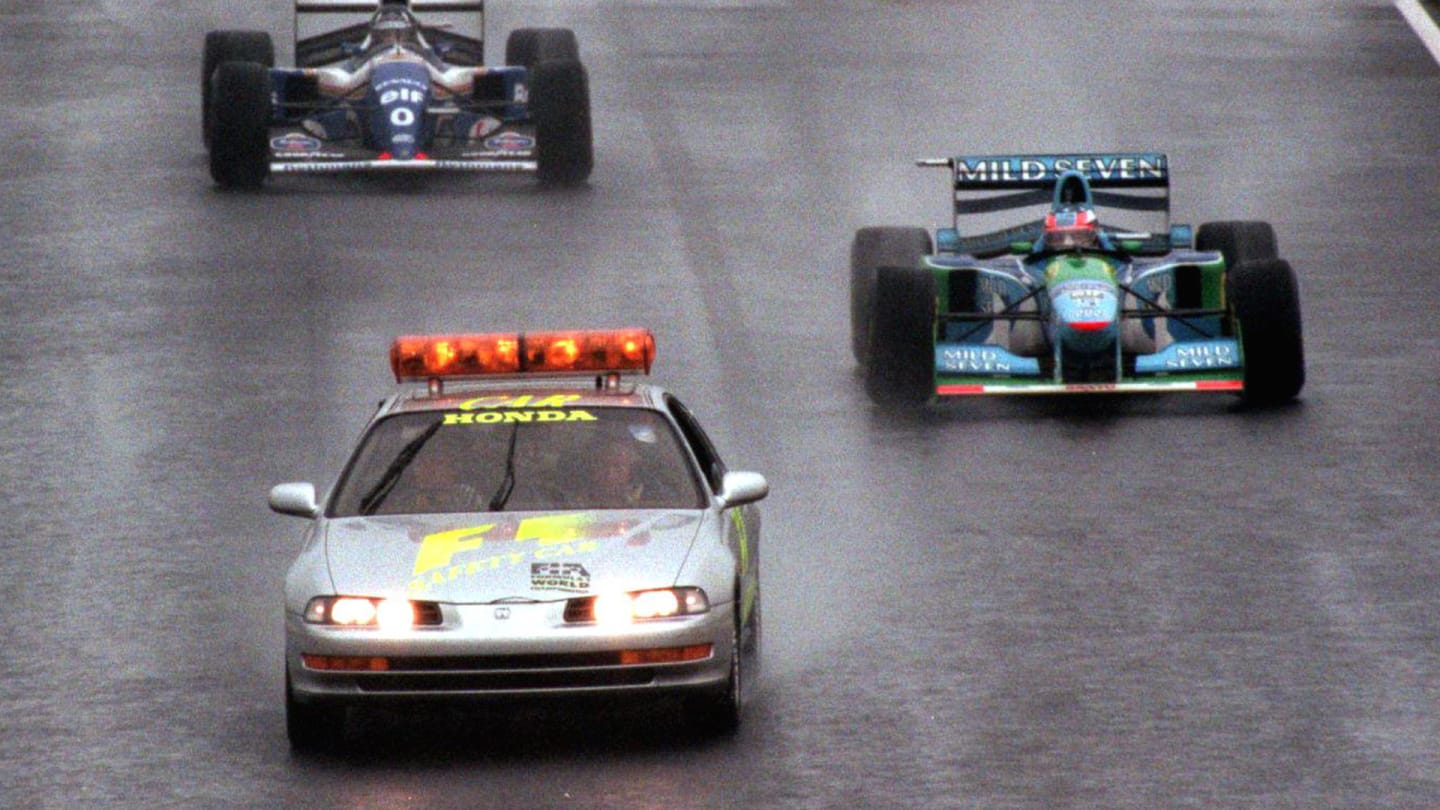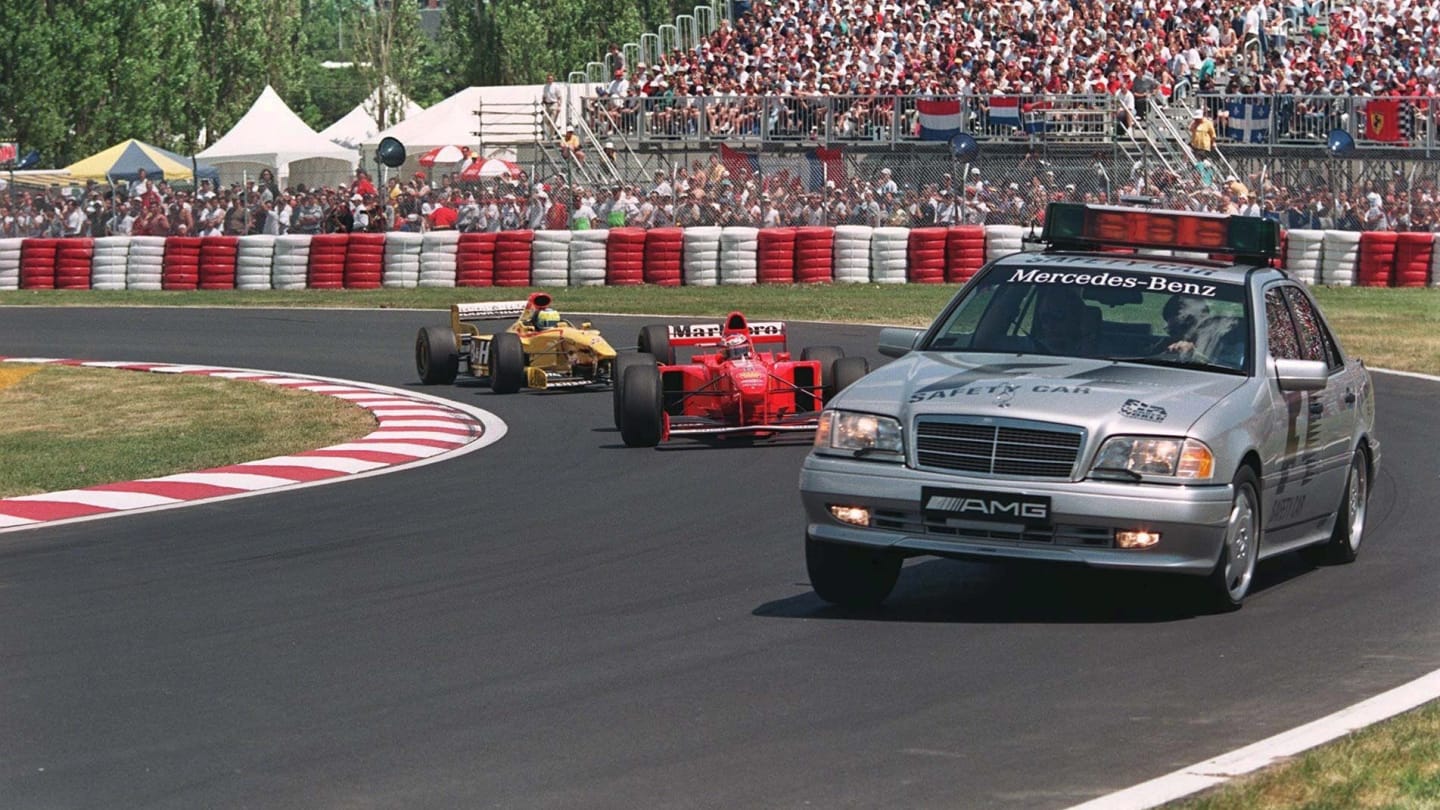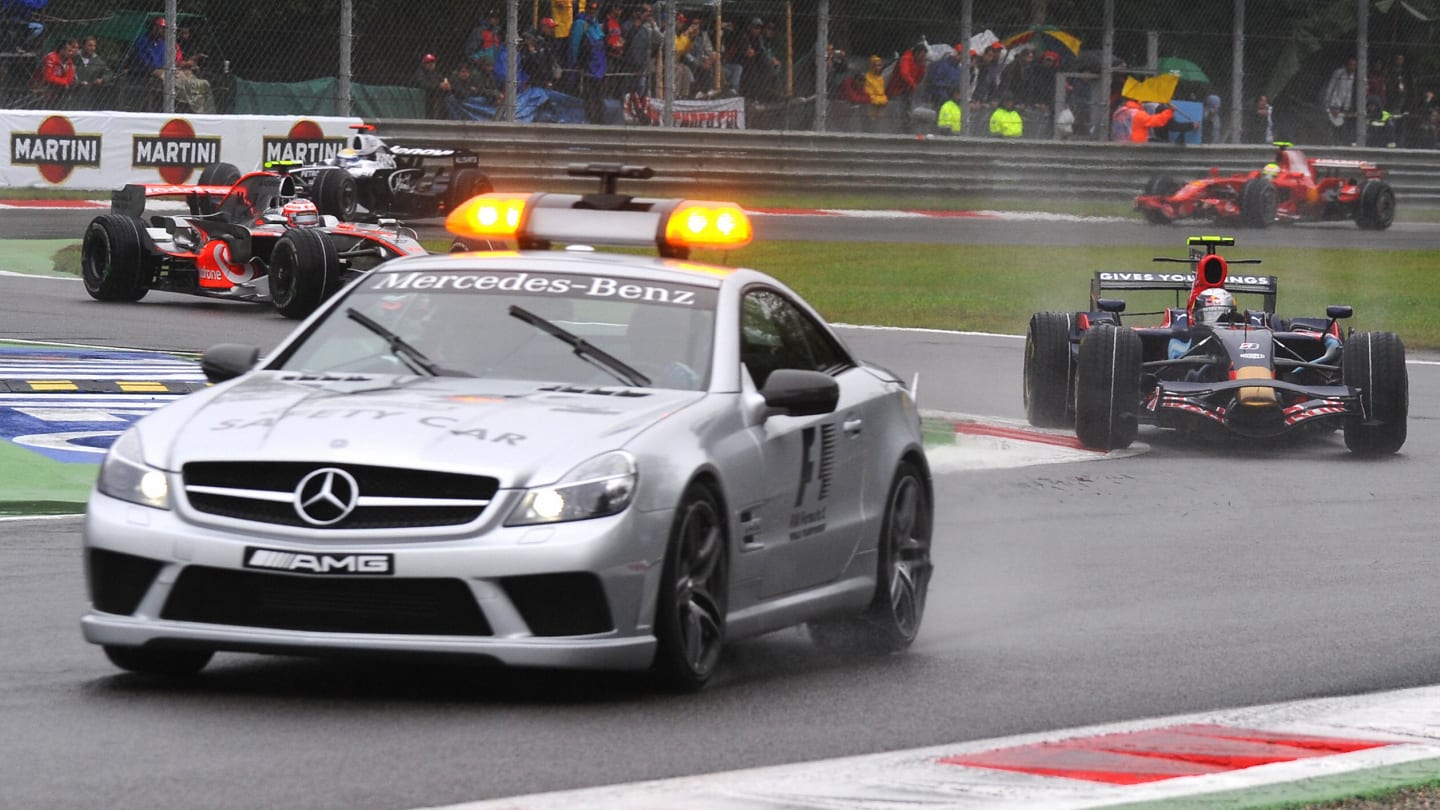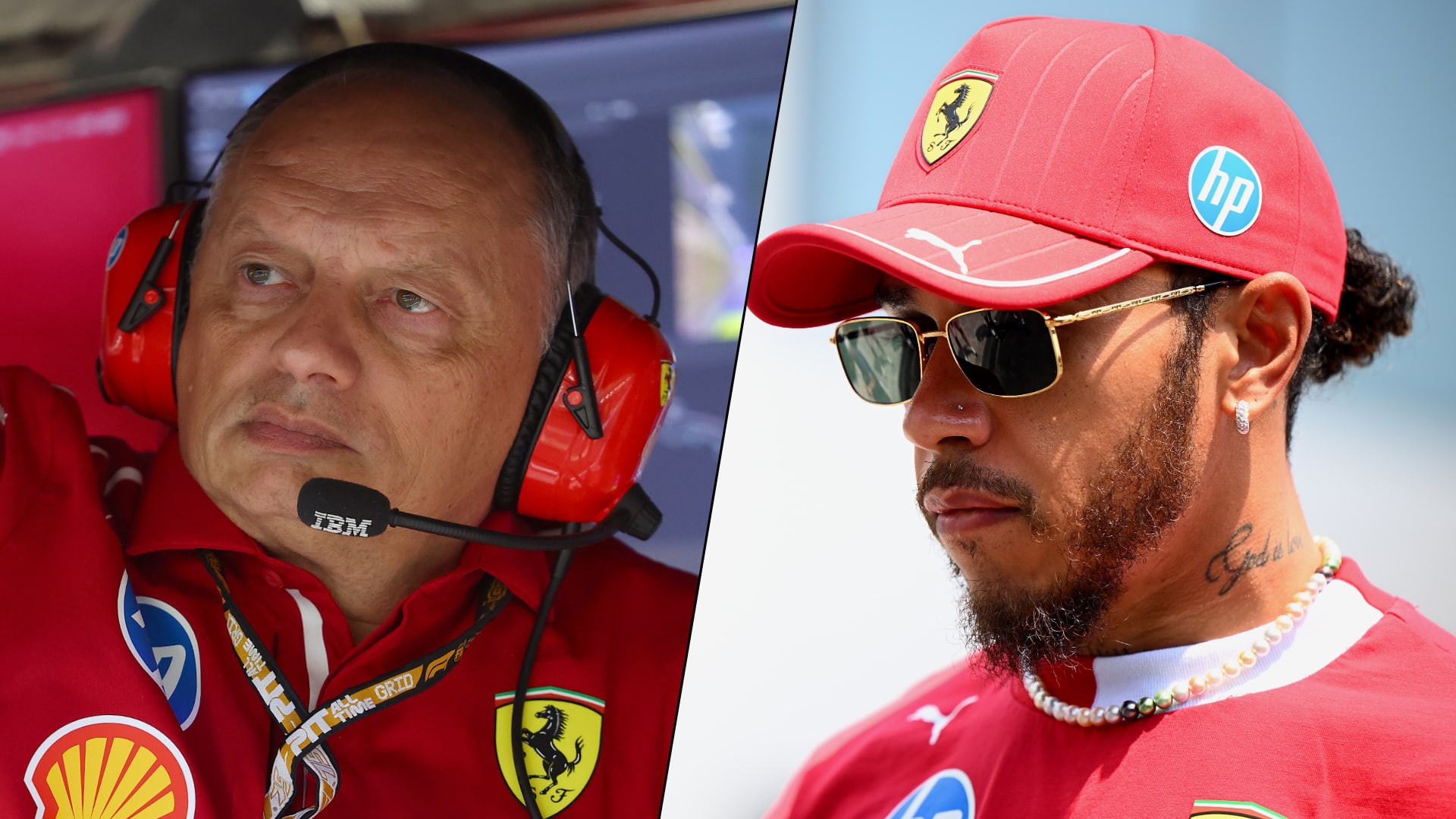)
Feature
TIMELINE: The 50-year history of the Safety Car's evolution in Formula 1

Share
)
This weekend’s Canadian Grand Prix marks the 50th anniversary since the introduction of the Safety Car in Formula 1. It may be a familiar sight to fans now but, since its arrival, it has evolved extensively over the decades.
There have been rule changes, manufacturer swaps, different car models – and even periods when the car wasn't around. But, whenever the car has been present on track, its appearance has altered significantly through the years.
To mark the special anniversary we have gone through the archives and put together a timeline of the history of the Safety Car in Formula 1 since that Sunday in 1973.
NEED TO KNOW: The most important facts, stats and trivia ahead of the 2023 Canadian Grand Prix
1970s
The Safety Car made its first appearance at the 1973 Canadian Grand Prix, as a result of several incidents caused by harsh weather conditions. To control the chaos, a slick Porsche 914 was deployed out on track, driven by former Canadian racing driver, Eppie Wietzes.
However, things did not run too smoothly, as the Safety Car picked up the wrong lead driver, causing most of the field to end up a lap down. This meant that it took several hours to figure out who actually won the race before Peter Revson was later confirmed the winner.
F1 Firsts: The first Safety Car in F1
1980s
The Safety Car was also used in the 1976 Monaco Grand Prix but, after a five-year absence, it returned to the same stage at the 1981 Monaco Grand Prix. The last time it was seen on the same Monte Carlo streets in 1976 it was in the form of a Porsche 911 but, on this occasion, it was a daring Lamborgini Countach.
The Countach then made a couple more cameo appearances at both the 1982 and 1983 Monaco Grands Prix, before the Safety Car would go into hiding for another decade.
WATCH: 5 great Canadian Grand Prix battles from the F1 archive

A Honda Prelude was the Safety Car of choice at the 1994 Japanese GP
1990s
It was not until the 1993 season that Formula 1 officially introduced the Safety Car as a fixture at all race weekends, after trial runs at both the British and French Grands Prix in 1992.
However, unlike these days when we have the same two Safety Cars parked at the end of the pit lane, individual race organisers were required to supply their own for the weekends.
This led to a lot of classic vehicles leading F1 cars out on track, such as the FIAT Tempra at the 1993 Brazilian Grand Prix, a Ford Escort Cosworth at the 1993 British Grand Prix, a Honda Prelude in Japan in 1994, a Renault Clio at the 1996 Argentine Grand Prix, and many more.
However, that all changed midway through the 1996 season, thanks to an agreement that has lasted until this day. Formula 1 and Mercedes joined forces, giving the German manufacturer the responsibility of supplying the Official Safety Car for all races.
This kicked off the Mercedes Safety Car era, with the Mercedes-Benz C36 AMG being used in 1996 and all throughout the 1997 season. That was before the decision was made to bring in the German brand's CLK 55 AMG for both the 1998 and 1999 campaigns.

Mercedes became the official Safety Car supplier in Formula 1 in 1996
2000s
Many things changed in the 2000s, most notably the Safety Car driver, as Bernd Maylander took over the reigns at the 2000 Australian Grand Prix. Since then, he has relinquished the responsibility just a handful of times – Monaco and Canada in 2001, and the United States in 2002.
Maylander has become an ever-present member of the grid and, while he hasn't changed, his car often has. The German kicked off his F1 spell behind the steering wheel of the Mercedes-Benz CL55, but that was quickly replaced after just one season by the SL55 AMG – which was around for the next two years.
As Formula 1 and the race cars continued to grow, so did the Safety Cars, as Mercedes made the switch to the CLK 55 AMG for 2003, but again Maylander only drove that car for a year.
For the 2004 and 2005 campaigns, the SLK 55 AMG was the Safety Car of choice, until it was later replaced by the CLK 63 AMG for the 2006 and 2007 seasons.
After two years, Mercedes deemed another change was necessary, with Maylander getting his hands on the SL 63 AMG, which was drafted in for both the 2008 and 2009 campaigns.

The Mercedes-Benz SL 63 AMG became the official Safety Car for the 2008 and 2009 seasons
2010s
2010 saw the introduction of the gull-wing door Safety Cars, with Mercedes bringing to the track the SLS AMG from 2010 to 2014. However there was a slight alteration during those years, as the GT version of the car was in operation from 2012 onwards.
The Safety Car continued to evolve in 2015, as for the next three seasons Mayländer would drive the eye-catching Mercedes-Benz AMG GT S-model out on track. However, since 2018, the AMG GT R was a fixture at Formula 1 race weekends.
New Aston Martin & Mercedes Safety Cars take to the track in Bahrain
2020s – Present Day
Mercedes continued to bring the AMG GT R in the 2020s, but a couple of major changes came in 2021. The Mercedes Safety Car that had traditionally been painted silver was now red, in an attempt to aid the drivers’ visibility during poor conditions.
IT’S RACE WEEK: 5 storylines we’re excited about ahead of the 2023 Canadian Grand Prix
However, that was not the only change we would see as, for the first time ever, Mercedes shared Safety Car duties with another manufacturer. Since 2021, the Aston Martin Vantage has been parked in the pit lane next to the Mercedes.
Maylander now either goes out on track in the Aston Martin Vantage or the Mercedes-AMG GT Black Series – which was introduced at the start of the 2022 campaign.
Without a doubt this timeline shows how much the Safety Car has evolved in Formula 1 over the last 50 years, but its role now is just as important as it ever was.
YOU MIGHT ALSO LIKE
News ‘I need to chill out’ – Norris opens up on early-season mindset as he admits to putting ‘too much pressure on myself’
News ‘It's all about patience’ – Bortoleto admits transition from F2 title winner to F1 backmarker is ‘not easy’
News Bayer admits Lawson left ‘sad and puzzled' by Red Bull seat swap as he predicts New Zealand driver 'will be back and he will be quick'
Podcast F1 EXPLAINS: Ask an F1 Team Principal with Alpine boss Oliver Oakes




